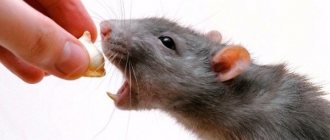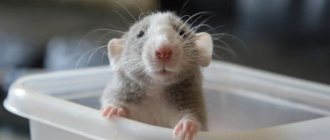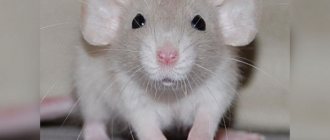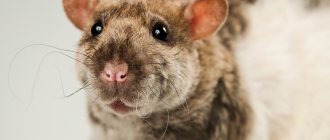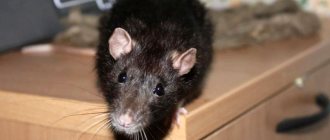Rats make great pets: they are smart, cute, and don't take up much space. However, sometimes a rat can bite its owner. If you're thinking about getting a new furry friend or you already have a rodent that bites, there are some steps you can take to prevent the behavior. It is also important to understand the causes of a rat bite.
Do house rats bite?
These are affectionate, kind animals. They are loving, adore their owner and show a positive attitude in every possible way. However, it happens that a pet suddenly bites.
It is worth noting that the bite of a decorative rat is very painful and quite strong, reaching 500 kg per 1 cm². The bite force allows wild brethren to gnaw concrete in search of food.
As a rule, a light, warning bite follows first.
Differences between rat bites and bites of other animals
A rat bite looks like two rather deep, most often bleeding wounds, consisting of two closely spaced punctures - marks of the upper and lower incisors, respectively. It is from such a trail that one can understand that the attacking animal was a rat. It is true that it is quite difficult to distinguish a rat bite from the bite of another rodent, since they are very similar in appearance. True, the rat's teeth marks are larger.
But in general there is no special need for such a diagnosis, since bites of any rodents are equally dangerous and require similar treatment.
Causes
To maintain good, friendly relationships, you should avoid situations in which the rat might bite.
- The pet was hurt;
- Scared;
- Hungry animal;
- The desire to attract attention.
Bites without a reason in domestic rats are practically excluded. If you squeeze an animal for a long time, then when it gets tired, it can gnaw lightly, thereby saying “enough.”
After preparing or eating food, you should also wash your hands thoroughly so that the smell of your fingers is not confused with food.
A rat may also bite another pet, such as a cat or dog. The reasons are the same - protecting one’s territory, fear, approaching danger. It happens that pets get along nicely next to each other and even play.
Any wounds sustained by pet rats should be treated, regardless of whether the bite was a human or a pet.
With a strong bite, the wound may not heal for a long time, especially in an animal when there is fur nearby, which constantly irritates the “battle wound.” Bites are painful, but by providing comfortable conditions for all family members to stay in the house, they can be avoided.
Pain
Like most other mammals and rodents in particular, a rat can bite when it experiences a sudden attack of pain. An accident could theoretically happen anywhere - during play and even inside the cage. Such a bite should be regarded as a defensive reaction.
If a hitherto calm animal suddenly begins to bite, there may be something wrong with its health, it is better to show it to a veterinarian. It is necessary to either immediately exclude the competence of veterinary medicine or begin treatment on time.
The rat suddenly started biting, what should I do?
If attempts to bite have not been noticed before, then a sudden change in the pet’s mood may be associated with hormonal changes. Girls' mood changes during pregnancy, and boys' mood changes during puberty. So, let's look at them separately:
- At the age of 5-7 months, males reach sexual maturity and hormones begin to play. The pet may want to be alone more, despite the fact that he previously liked to communicate with the household inhabitants. The defense of the territory begins precisely at this moment; there is a claim to ownership.
- Females are more likely to respond to changes in the body during pregnancy and when caring for children. This is where the maternal instinct of domestic rats manifests itself. They love their babies very much and carefully take care of them, and therefore, even with slight danger or anxiety, they can bite.
These are natural stages of growing up, which some animals experience more smoothly and gently, while others endure them quite aggressively. Do not forget that a pet can bite because of jealousy.
Astonishment
Try not to wake or disturb your pets while they sleep. Do not approach them on the sly - the animals must see that you are approaching. Throwing a “surprise” at your pet by suddenly grabbing him in your arms is a very bad idea.
Always pay attention to this. Do not perform any lightning-fast, impulsive actions with your rat. Even when you move the rat to clean out the cage, your actions should be predictable.
A few words in conclusion. When handled correctly, rats are extremely peaceful and friendly creatures. It takes a lot of effort to make a rat angry! But remember that their teeth are as sharp as razors; weigh all the circumstances that we talked about in our article. Thoroughly study the literature on the proper care of rats, study their behavior, keep yourself within limits - and you will never be bitten by your pet.
Original publication: Reasons Why Rats Sometimes Bite. Source and photo:
What to do if bitten by a domestic rat?
Pay attention to your pet, maybe he wants something or is warning about something. A decorative rat will not bite on purpose to hurt. This could be anything: from a desire to attract attention to a warning.
Rats often play this way with other pets; they can run up, bite, for example, the ear and run away. Then return and repeat in a circle. Sometimes they lightly pinch with their teeth or bite them - such caresses are evidence of the pet’s great love, a manifestation of care. Scratches or abrasions may appear during play, but this is not dangerous.
Providing assistance to the victim
A rat bite is especially dangerous for a child. First of all, the child’s body does not yet have a strong enough immune system and is therefore susceptible to many pathogenic infections. In addition, children do not always immediately tell their parents about their injuries. At the time of a complaint about illness, the infection may already have spread through the bloodstream, which will significantly complicate the treatment process, although such unpleasant consequences could be avoided if medical assistance is provided in a timely manner.
The first thing to do, regardless of whether the bite was from a domestic rat or a wild one, is not to try to immediately stop the bleeding. Additionally, you can press on the edges of the wound to allow the bleeding to remove the maximum amount of pathogenic bacteria. Next, you need to immediately treat the wound with hydrogen peroxide. If you do not have such an antiseptic at hand, the affected area should be washed well with soap. Immediately after providing first aid you should go to the hospital. As a rule, after a rodent bite, the patient is prescribed a therapeutic course consisting of the use of antibiotics. The affected area will need to be lubricated with ointments that also contain an antibiotic.
Most often, the patient is prescribed Oxytocin, but another drug may be recommended. The course of treatment and dosage are prescribed by the doctor individually depending on the patient’s condition, his symptoms and age.
If a wild rat bites, the victim must be given an injection for tetanus and rabies. In the case of domestic rodents, the patient is also recommended to receive such vaccinations, since one cannot be sure that the animal was completely healthy at the time of the bite. An alternative option in this situation is to check your pet for infections in the body.
As a rule, there is no need for hospitalization after a rodent bite. But if the patient does not promptly treat the wound and begin treatment, serious complications may occur. In such situations, hospital treatment under strict medical supervision is recommended.
Source
A rat bitten until it bled: first aid
The wound is usually deep, very painful and has difficulty healing. In this case, the edges are quickly tightened, which prevents blood from escaping, which could have become infected.
Algorithm of actions:
- First of all, squeeze out as much blood as possible from the wound to eliminate the presence of dirt.
- Rinse under running water for at least 5 minutes.
- Then treat the bite site with any antiseptic: hydrogen peroxide, chlorhexidine, a weak solution of potassium permanganate.
- Apply iodine or brilliant green to the wound.
- If necessary, cover with adhesive tape.
- Monitor your health for a few days. And do all household chores with gloves.
Wound treatment is the same for adults and children.
It is of great importance that the pet is truly domestic, vaccinated and kept in good conditions.
If a rat bites a child, be sure to talk to the child and explain how to handle the pet. The bite could occur after the animal was squeezed too hard, hurt or scared. The main thing is to explain to the child that the rat must be handled carefully and then it will not cause trouble.
What symptoms indicate infection?
There is a whole set of characteristic signs, upon the appearance of which a person bitten by a rat should be shown to a doctor as soon as possible.
The most common diseases that occur a few days (weeks) after rat bites are manifested by a typical fever with characteristic symptoms:
- Increased body temperature;
- Chills;
- Severe malaise and general weakness;
- Pain in the head;
- Digestive disorders, diarrhea, nausea, abdominal pain.
These are signs of most viral and bacterial fevers, leptospirosis and pseudotuberculosis. As a rule, they develop approximately a week or two after the bite, but sometimes the incubation period drags on up to a month, or, conversely, lasts only literally a few hours or a day. This, by the way, is one of the difficulties of diagnosis - often by the time symptoms appear, a person has already forgotten that he was bitten by a rat.
Here, for example, are the characteristic signs of tetanus:
- Acute pain at the site of the bite, even if the bite itself has long since healed (several weeks after the rat attack);
- Muscle twitching at the site of the bite;
- Tension of the chewing muscles, sometimes not allowing you to open your mouth at all;
- Insomnia;
- Excruciating back pain.
With sodoku, in addition to pain, an infiltrate with constantly leaking fluid may develop at the site of the wound. With a nonspecific local infection, a painful inflammation first appears here, and then a characteristic abscess.
It is also useful to read: Black rats: photographs and interesting facts about the life of these rodents
In general, there is no need to remember these symptoms. Any disturbance in the general health of the victim in the weeks following the rat attack is likely to be related to the bite itself. Moreover, the first “bell” can be not only a generalized sign, but also local manifestations - pain, itching, spontaneous muscle contractions near the wound, even if it has healed. None of them should be ignored, and if symptoms are obvious, you should see a doctor as soon as possible.
How to stop a rat from biting?
It will take patience and desire. There are specimens that themselves do not like communication and want to be left alone. If an animal bites during play, or there is a hormonal surge, then all the miracles of diplomacy must be applied.
In the process of fighting for territory, the rat that puts its opponent on its back wins. If the pet tries to bite, you should put it on its back and hold it in this position for 20-40 seconds.
Working with a spray bottle is considered a safe way. If bitten, spray a little with water using a spray bottle. After 5-7 times the rodent will understand that it is not worth biting.
When the animal has grown up and got used to the owner, simply drive him away and not let him near, so that the rat understands that you are not inclined to communicate in such a way.
You shouldn’t hurt your pet, click him on the nose, pick him up by the tail, and especially not deprive him of food/water or take him out to the balcony in winter. Such methods are more likely to cause additional aggression, undermine health and will not lead to the desired result.
Redirected aggression
If two rats divide spheres of influence and find out which of them is in charge, you risk becoming a victim of redirected (indirect) aggression. Don't get caught between warring rats and don't take the bite personally: as they say, it was nothing personal. Soon everything will be forgotten, no complaints against you.
If you nevertheless decide to take on the duties of a referee and want to separate the fighters, then you need to prepare thoroughly. First of all, protect your hand by wrapping it in a thick cloth. Second, splash water on your pets. If you were bitten, take it for granted.
Can a person get sick after being bitten by a pet rat?
Despite the fact that the rodent spends its entire life completely isolated from the environment, it is capable of infecting a person through a bite. This is due to the fact that germs and bacteria from the environment can enter an open wound.
The first signs of infection:
- Severely visible inflammation of the wound. Accompanied by redness, pain and swelling.
- The occurrence of headache or muscle pain.
- Temperature increase.
If any of these symptoms appear, you should definitely consult a doctor.
Some bites can be fatal to humans, especially if not treated promptly. This mainly applies to wild brothers. Animals purchased in unknown places (bird market, hand-held, uncertified pet store, etc.) can also pose a danger to humans.
What you can get infected with:
- Streptobacillosis - another name is Haverhill fever. The disease is dangerous because the lack of treatment in 10% of cases can lead to death. You can catch it not only from a bite, but also from kissing an animal, when cleaning a cage, or from getting a pet’s blood on a small human wound.
- Hemorrhagic fever—infection occurs when animal excrement or urine enters the human body. It can also cause death due to kidney damage. The initial stage is characterized by high fever, headache, hemorrhages on the mucous membrane and skin.
- Leptospirosis is transmitted by saliva, urine and feces, and the rat must also be previously infected. The bacteria of this disease affect the liver, kidneys, and intestines.
- Paratyphoid and helminths - diseases from a series of worms are dangerous not only for humans, but also for rats, they are transmitted through poor hygiene and kissing a pet.
- Tularemia is rare, but can occur in domestic rats; the disease is more common in wild animals and cattle. If ingested, it causes severe fever, loss of appetite, and may cause vomiting and nosebleeds. Hospitalization and treatment with antibiotics are required.
Decorative rats can become infected from bad water, stale food, or poor home hygiene. It is necessary to wash your hands thoroughly after contact with the animal and clean the cage on time.
If any symptoms appear, especially inflammation of the bite and fever, you should immediately consult a doctor. You should not take any action on your own.
Antibiotics are prescribed only by the attending doctor after identifying the disease and prescribing a course of treatment. Timely treatment will help avoid negative consequences.
Particular attention should be paid to pregnant women when in contact with animals. It doesn't matter whether it's a rat, a dog, a cat or a cow. Any animal walking in the yard or living in the apartment, one way or another, can affect the fetus of a pregnant woman.
Rat fever
Rat fever is a human disease that is transmitted by rodents, especially rats, and can affect humans mainly after exposure to rodent urine. The secretion coming from the rat's mouth, eyes or nose is a source of streptobacilli and is usually transmitted after direct contact with the animal, such as a bite.
Any animals that people live with can also carry the disease if they have been close to an infected rodent.
When the fever is caused by the bacterium Streptobacillus moniliformis, treatment usually takes 3 to 10 days. The most common symptoms of rat bite fever caused by this bacterium are:
- headache;
- elevated temperature;
- skin rash;
- myalgia (muscle pain);
- arthritis (especially in the knees);
- vomit;
- diarrhea;
- pneumonia;
- meningitis.
If you notice the above symptoms, you should consult a doctor
Spirillum minus is another common bacteria that can be transmitted by a rat bite and leads to a slightly different type of rat fever, which includes symptoms such as:
- elevated temperature;
- headache;
- swelling of the lymph nodes;
- skin rash;
- muscle pain and arthritis;
- a sore throat;
- pneumonia;
- hepatitis;
- ulcers near the bite.
If any of these symptoms occur after being bitten by a pet rat, you should immediately consult a doctor.
When and why do rats attack people?
Usually there is no point in attacking a person for these animals; it is easier for them to quickly hide so as not to expose a strong rival to a conflict. So there are only a few reasons for aggressive behavior:
- rabies infection. The consequences of this disease cause unreasonable aggression in the animal and an acute reaction to all pathogens - this means that an infected animal can attack for no reason;
- Often a rat bites a person purposefully in an attempt to defend itself or protect its offspring. An animal driven into a corner is simply afraid, and therefore tries with all its might to snatch at least two seconds to escape, even if it means biting the offender’s finger;
- there were cases when a whole flock of rats, driven out of their habitat, made desperate attempts to attack those around them;
- extreme hunger can force an animal to take risks such as attacking a stronger creature. Also, a hungry rat can bite if a person suddenly reaches out his hand in an attempt to take away the food that it is currently eating.
It is worth clarifying that in our region attacks for no reason are very rare, because animals can find enough food to feed themselves and stay close to a person without showing aggression towards him.
First aid for a bite
There are several steps you can and should take:
- If you are not a victim and are treating someone else's bite, follow universal precautions and use personal protective equipment, if available.
- Stop the bleeding and wash the wound with warm water and soap. Clean the inside of the wound, making sure to rinse off all the soap otherwise it will cause irritation later.
- Cover the wound with a clean, dry bandage. You can apply antibiotic ointment to the wound before covering it.
- If the injury is on a finger, remove all rings from the injured finger before it swells.
- You should have your rat checked by a veterinarian to determine if the animal has an infection.
Treatment
If the bite leads to rabies, the victim needs emergency vaccination. Now they are given not in the stomach (30 injections), but in the shoulder - 5-6 vaccinations. The first must be done on the day of the attack.
Subsequent ones - on days 3, 7, 14, 30 and 90. If you complete a full course of vaccination, then even after a person is bitten by a rabid rat, he can save his life.
Bites localized to the head or face are especially dangerous . If the wound is too deep, you will need to administer antibacterial agents and use drainage. Or you have to get stitches.
Actions with a rat that bit your hand
If in a dream a rat bites your hand, the interpretation of what you see depends on your further actions:
- Catching a rodent means coping with problems. If this is done with bare hands, the dream indicates an honest resolution of the conflict and contempt for human meanness.
- To strangle - to victory over the enemy. The main thing is not to lose your head in a conflict and act calmly.
- If after being bitten you had to run after a nosy rodent, it means there are hidden enemies among your closest friends.
- Killing a rat means recovery from a serious illness.
- It’s a good sign if you managed to prevent yourself from being bitten. The dreamer will be able to avoid an unpleasant situation; the machinations of enemies will not bring results.
- Running away from a rodent means admitting complete powerlessness in the face of the situation.
Rats. Who are these toothy pests?
Rats are a species of rodent that inhabits the entire world. And there is no place where these tailed creatures are not found: they are amazingly adaptable and omnivorous, which helps them survive in absolutely any conditions. Interestingly, their habitat previously did not cover the islands and continents of America. And they got there only at a time when brave sailors, with a desire to discover new lands, accidentally brought rats with them on ships.
In total, there are about 137 species of rats, as well as 567 of their subspecies and races. In Russia you can find only three of them: the Turkestan, gray and black rat.
These pests go hunting mainly at night, therefore, they can rarely be seen and that is why it may mistakenly seem that they are not in the house at all. They simply reproduce at a tremendous speed: each female can give birth to up to 15 cubs every 3-4 months, despite the fact that the offspring reach puberty after 1.5 months.
These animals are well adapted to living in cities and are practically omnivores. Food includes grain, fruits, waste from the human table and various plants. But they will not refuse to feast on animal protein: attacks on small birds and amphibians are not uncommon.
There are also cases when these animals ate each other. Such a diet makes you wonder if a rat could attack a person to try what it tastes like?

